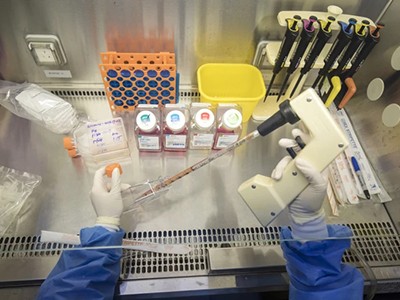Increasingly, agricultural scientists in Asia and Africa are using the gene-editing tool CRISPR to develop disease-resistant, high-yield crop varieties. Many, especially those in government research laboratories, are underestimating the importance of the patent and licensing rules that surround tools such as CRISPR.
The holders of patents on the CRISPR–Cas9 system have rights over discoveries made with it, because their invention makes those discoveries possible. Indian researchers have been able to use CRISPR–Cas9 legally since 2022, when the Indian Patent Office granted a local patent on the tool to the Dublin-based company ERS Genomics. ERS sets the rules of the tool’s use. As a result, scientists can use CRISPR for academic purposes, but cannot commercialize any resulting scientific breakthroughs.
CRISPR cures and cancer vaccines: researchers can help to shepherd them to market
In agriculture, that’s a problem. I made a similar mistake when starting my career in 1997. As a biotechnologist at the Indian Council of Agricultural Research (ICAR), I was assigned as one of the principal investigators of the project to develop genetically modified, pest-resistant Bt cotton.
Producing transgenic crops such as Bt cotton involves incorporating foreign DNA — in this case, genes from the bacterium Bacillus thuringiensis (hence ‘Bt’) — into a crop’s genome to induce desired traits. Indian scientists published a lot of research on transgenic crops in the 2000s, but the patent on the relevant Bt gene was held by the agrochemical company Monsanto (now owned by Bayer in Leverkusen, Germany), which did not allow commercial use of the research results. Ultimately, Indian farmers could not reap the benefits of state-subsidized seed varieties; those using Bt cotton now rely on expensive proprietary seeds.
Having witnessed one failed project, I urge scientists in low- and middle-income countries to pay more attention to who owns CRISPR–Cas9 patents and under what terms they are willing to license this innovation.
‘ChatGPT for CRISPR’ creates new gene-editing tools
For instance, India’s ministry of agriculture has launched a 5-billion-rupee (US$60-million) initiative to expand genome-editing research to develop climate-resilient and bio-fortified seed varieties. Scientists in India who rely on patented toolkits to ramp up their research output will be wasting their time if those seeds cannot be sold.
India already has fewer CRISPR patents than countries such as China and the United States. Acquiring commercial licences for full use of patent-protected CRISPR toolkits can be expensive. For example, in 2023, Vertex Pharmaceuticals in Boston, Massachusetts, secured approval to sell its CRISPR-based treatment for sickle-cell disease only after paying $50 million up front in fees to a licence-holder authorized by the Broad Institute, a genomic-research centre in Cambridge, Massachusetts, that holds the patents.
Indian researchers could turn to freely available CRISPR toolkits offered by non-profit repositories such as AddGene in Watertown, Massachusetts. But these, too, can be used only for research, and not for commercial purposes. Another option is to negotiate licences for a patent pool, which would allow access to multiple patents at once.
A ‘one nation, one licence’ policy for CRISPR toolkits could allow Indian researchers and institutions to access gene-editing technologies under a single government-negotiated agreement, reducing costs and simplifying access. It would be similar to the ‘one nation, one subscription’ initiative, launched last month, which provides researchers across India with universal access to scientific journals. ICAR’s public–private partnership programmes could be leveraged to raise the necessary funds.
EU proposal on CRISPR-edited crops is welcome — but not enough
The best way forward, however, is to do the grunt work and develop home-grown CRISPR toolkits, as China seems to be doing. Until now, components of the kits, such as the protein Cas9, have been discovered mainly by studying microorganisms, which use molecular scissors to detect and destroy the DNA of invading viruses. India’s vast microbial biodiversity and its expertise in artificial intelligence, which can be used to analyse genetic data and predict viable proteins, could catalyse the discovery of molecular pathways by a different route.
Already, the prohibitive cost of commercially available CRISPR-based gene therapy for sickle-cell disease — up to $3 million per recipient — has prompted researchers at India’s Institute of Genomics and Integrative Biology in Delhi to develop low-cost, locally made CRISPR tools to make such treatments more affordable. Agricultural scientists need to do something similar.
Indian funding agencies should review proposed projects to genetically modify seeds, to ensure that they address intellectual-property concerns and have clear commercial applications. This would help to align funding with projects that can have real-world impact and economic value for farmers. Agricultural scientists in low-income countries also need adequate training in the business and economic principles of modern biotechnology research.
Farmers in India want to grow climate-resilient rice or sweet pink pineapples, which could be developed with the aid of CRISPR. Under current standards, these crops face fewer regulatory hurdles for field trials than do transgenic varieties, making their adoption easier. To improve the economic well-being and food security of millions of people, agricultural scientists must devise ways to navigate the intellectual-property thicket and develop products that can be commercialized.
Competing Interests
The author declares no competing interests.





